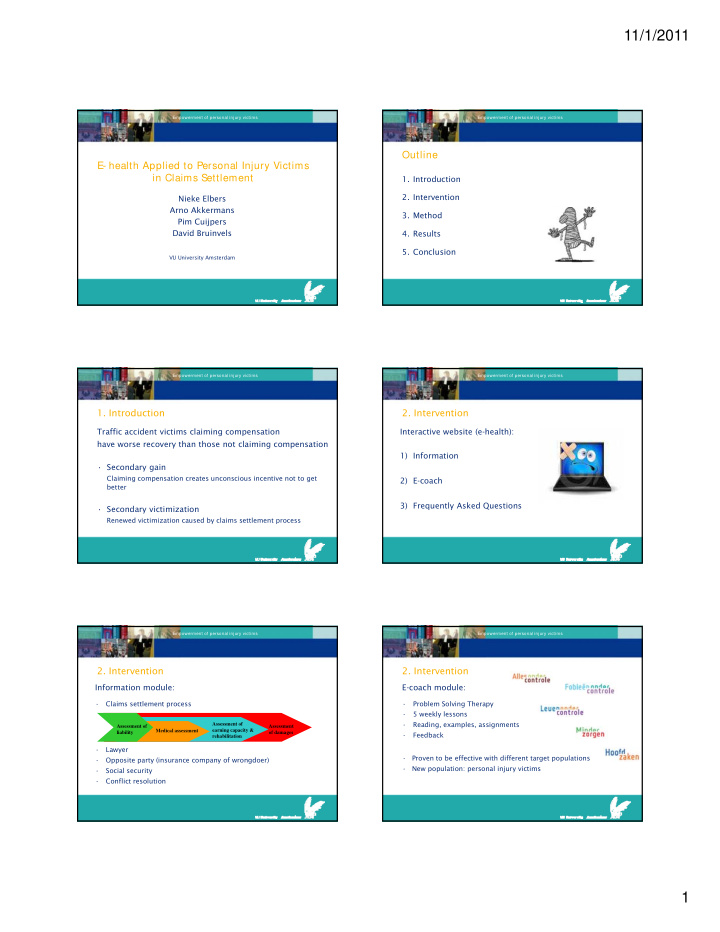



11/1/2011 Empowerment of personal injury victims Empowerment of personal injury victims Outline E- health Applied to Personal Injury Victims in Claims Settlement 1. Introduction 2. Intervention Nieke Elbers A Arno Akkermans Akk 3. Method Pim Cuijpers David Bruinvels 4. Results 5. Conclusion VU University Amsterdam Empowerment of personal injury victims Empowerment of personal injury victims 1. Introduction 2. Intervention Traffic accident victims claiming compensation Interactive website (e-health): have worse recovery than those not claiming compensation 1) Information • Secondary gain Secondary gain Claiming compensation creates unconscious incentive not to get 2) E-coach better 3) Frequently Asked Questions • Secondary victimization Renewed victimization caused by claims settlement process Empowerment of personal injury victims Empowerment of personal injury victims 2. Intervention 2. Intervention Information module: E-coach module: • Claims settlement process • Problem Solving Therapy • 5 weekly lessons • Reading examples assignments Reading, examples, assignments Assessment of Assessment of Assessment of Assessment earning capacity & Medical assessment liability of damages • Feedback rehabilitation • Lawyer • Proven to be effective with different target populations • Opposite party (insurance company of wrongdoer) • New population: personal injury victims • Social security • Conflict resolution 1
11/1/2011 Empowerment of personal injury victims Empowerment of personal injury victims 2. Intervention 3. Method Validation website: Participants: Traffic accident victims (n=170) • Accident < 2 years ago • Focus group • Age > 18 years old • 5 insurance companies (defendants) and 6 lawyers (plaintiffs) 5 insurance companies (defendants) and 6 lawyers (plaintiffs) Procedure: • Pilot 8 traffic accident victims Empowerment of personal injury victims Empowerment of personal injury victims 4. Results 4. Results Baseline independent variables Baseline dependent variables 5 All (n=172) Intervention (n=85) Control (n=87) P-value 0 ‐ 1 year old 4,5 Age (years) 48.7 ± 14.7 49.0 ± 15.0 48.5 ± 14.5 .80 1 ‐ 2 years old 4 Male (%) 54 51 58 .37 3,5 Injured body part (%) j y p ( ) n(0-1) = 92 n(0 1) 92 3 Shoulder, arm, hand 52 49 54 .55 n(1-2) = 80 49 51 48 .76 Head or neck 2,5 p = .02 49 45 54 .22 Hip, leg, foot 2 Trunk or back 31 37 25 .11 1,5 Hospitalization (%) 42 39 46 .35 1 If yes, how many days 9.4 ± 11.0 11.2 ± 12.7 8.0 ± 9.3 .22 Empowerment Depression Anxiety Somatic symptoms Whiplash (%) 31 35 28 .28 Empowerment of personal injury victims Empowerment of personal injury victims 4. Results 4. Results 10 Website usage: 9 0-1 year old • Baseline 3 months (n=59) 8 1-2 years old p = .05 7 Login at least one time 6 6 n(0 1) 92 n(0-1) = 92 Login not once 5 n(1-2) = 80 Information module: 4 61% 3 Page views: 9 ± 7 2 1 E-coach module: 0 None! Self efficacy Quality of life Work ability Burden 2
11/1/2011 Empowerment of personal injury victims Empowerment of personal injury victims 5. Conclusion • Participants longer involved in compensation Thank you feel worse than participants just involved in compensation Strengths: placebo control (instead of waiting list control) and pragmatic, real life conditions l l f d Contact information: − Limitation: Limited generalization to PI victims in general and to Nieke Elbers countries with different claims settlement processes n.elbers@vu.nl • First e-health intervention in the field of (liability) law: unexplored research area with a lot of potential 3
Recommend
More recommend